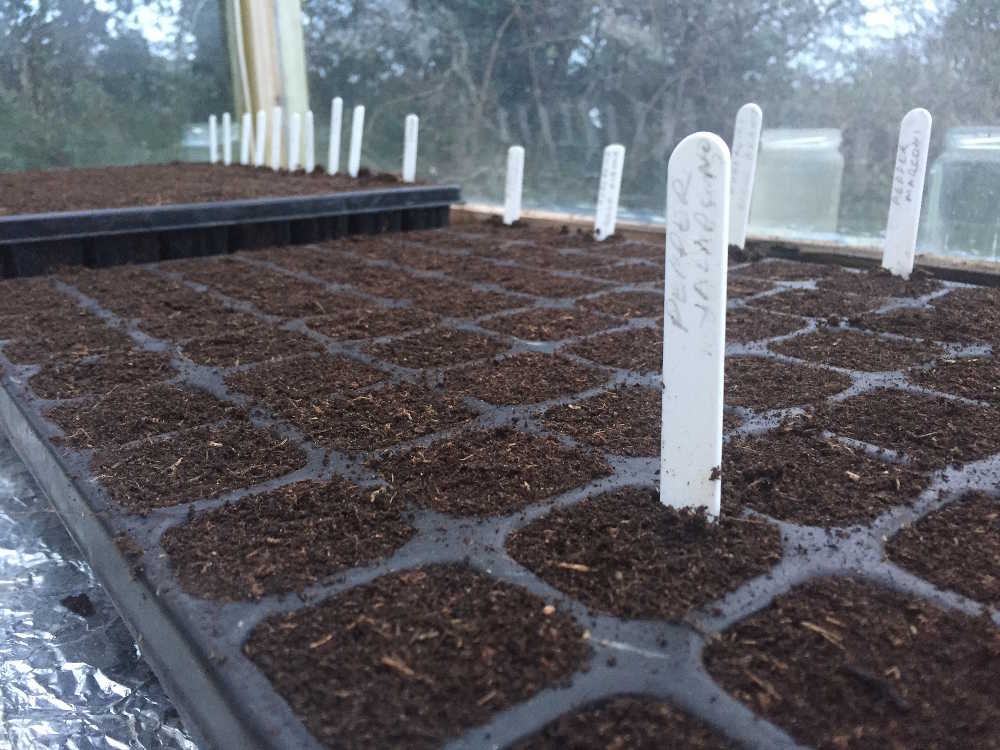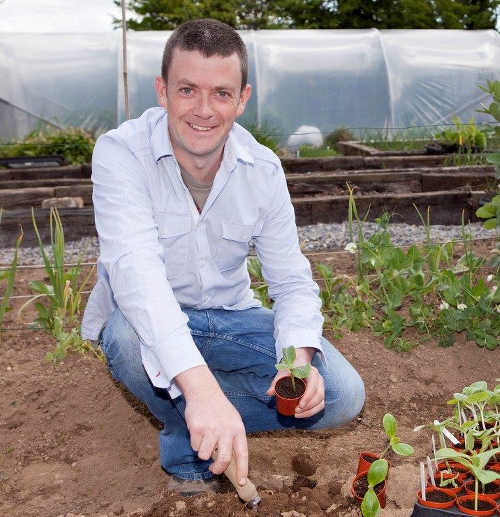Grow It Yourself - March

I absolutely love being a GIYer at this time of the year. It’s hard not to feel all spring-like and full of hope about life in general when one sees a little green seedling emerging from the cold, brown earth. I want to talk a little about seed sowing in general, which can be such a challenge when you’re starting out with your GIYing, but is relatively straightforward once you get a bit of a system going.
In particular I want to talk about seed sowing “indoors” – that is, those seeds that are sown in protected conditions rather than sown directly in the soil outside. So, here’s how it breaks down. I sow the following vegetables directly in the soil outside in the vegetable patch: potatoes, onions, garlic, shallots, peas, beans, parsnips and carrots.
Pretty much everything else I sow indoors first and then (usually about 4-6 weeks later when the seedlings are a little bit hardy), I plant them out in the soil. The vegetables I sow this way include lettuce, tomatoes, aubergines, peppers, sweetcorn, broccoli, cabbage, kohlrabi, Brussels sprouts, cauliflower, celery, celeriac, beetroot, spring onions, courgette, cucumber, kale, pumpkin, squash, spinach and turnip.
Sowing seeds directly outside is of course, a far easier way to do things. So why do we bother doing it a more convoluted way? Put simply, it’s far more effective. A seed sown in the soil outside has a lot to contend with in that difficult first 8 weeks of its life – among other things: frost, snow, rain, wind, slugs, snails and birds.
By sowing indoors you are giving the seedling a chance to get itself established before it has to deal with these threats. As a result, you’re more likely to convert your seed sowing in to food eating, which let’s be honest is the whole point.
Incidentally the word “indoors” can have many different meanings for different people. When I started growing first, sowing indoors meant actually sowing them inside the house. But when that got a bit out of control, I got myself a greenhouse/potting shed with benches where I grow seedlings. So, when I think of sowing “indoors” I am referring to the potting shed.
Sowing indoors also allows you to cheat on the growing season – by creating a warmer ambient temperature than that which exists outside, you can extend the growing season at either ends. This is particularly important for vegetables that have a very long growing season – examples are tomatoes, aubergines and peppers.
You can cheat even further by buying a heated propagation unit which provides your seedlings with heat from beneath. Seed germination and subsequent seedling growth is more reliable and faster when using a propagation unit, particularly at this time of the year when the air temperatures are low.
Things to do this Month - March
To Do
Continue to prepare ground – there is still time to prepare a plot to grow veg this year. Fork or rake over existing beds, breaking up large clods of earth. Cover new seedlings with fleece if a frost is due. Start your daily slug patrols and lay beer traps. Don’t let new-season weeds take over – get on top of them with weekly hoeing.
Sow
Indoors: lettuce, aubergine, peppers, cucumbers, celery, celeriac, sweet corn, basil, leeks, summer cabbage, cauliflower, Brussels sprouts, parsley, courgette, French beans.
Sow outdoors or under cover: broad beans, red cabbage, carrots, cauliflower, spinach, kale, Brussels sprouts, onions, leeks, turnip, peas, radishes, early lettuce, asparagus. Plant your first early seed potatoes, as soon as weather conditions allow.
Harvest
This month you could be enjoying (from the ground and from storage) onions, leeks, parsnips, potatoes, some varieties of lettuce, mint, sprouting broccoli, kale, rhubarb, chard, the first of the spring cauliflowers and cabbage, and spinach (perpetual, spinach beet).
Recipe of the Week – Borscht
This recipe was sent to me by Chris Betts, a GIYer from Tramore. It’s a brilliant way to use garden vegetables at the end of the season and makes a very tasty and nutritious lunch dish. You can be flexible with the ingredients, with Chris saying that only the beetroot is critical (otherwise it’s not borscht)! Make a big batch of this and freeze it.
Ingredients:
• ¾ lb each of lean pork and cooked bacon, diced
• 6 or more large beetroot
• 2 large onions
• 1 small celeriac or 2 sticks celery
• 1 leek
• 1 large turnip
• 1 large swede
• 1 or 2 parsnips
• 4 carrots
• 1 lb potatoes
• Half a cabbage
• Haricot or cannelloni beans, soaked overnight, to produce ¾ to one pint
• Olive oil
• Approx 1½ pints stock or water
• 1 or 2 tablespoons cornflour
• Plain yoghourt to garnish (if liked)
Directions:
Roughly chop/dice all veg. Saute onions lightly in oil, then add diced pork and brown all sides. Add vegetables and cook for a few minutes on medium heat, stirring to distribute oil evenly. Add the beans and sufficient stock or water to cover.
Bring to the boil, stirring occasionally, then add the cooked bacon, salt if required, and pepper to taste. Simmer for about 40 mins until everything is soft.
Mix cornflour to a paste with cold water in a small bowl or cup, add some of the liquid from the pan to it, stirring, then trickle into pan, stirring constantly. Adjust thickness to own preference (this can be done after defrosting if preferred).
When serving, add a dessert spoonful of yoghourt to each bowl.
Tip of the Month – Grow Red Cabbage
We’ve grown red cabbage for a few years now and it’s a very straight-forward, reliable plant to grow - pretty much untroubled by slugs and other pests once you get it started. It is also excellent for late summer coleslaws and will survive tough winters in the ground. Red cabbage is very easy and reliable to grow from seed, so there’s no real need to buy those expensive plants in modules. Sow the seeds in a seed bed or in modules (one seed in each cell) and they will almost certainly reward you with fine plants later on.
GROW HQ
The home of the GIY movement and our brand new food education centre, GROW HQ, is finally open in Waterford city. In addition to our 65-seat home-grown food café and shop, we’ve a range of growing and cooking courses happening weekly – for courses happening this month, check out www.growhq.org
Join GIY
By joining GIY you help us to continue the work of supporting people just like you to grow food at home, at school, in the workplace and in the community – each year we support over 65,000 people and 1,500 community food growing groups and projects. It costs just €35 to join GIY for a year, and to say thanks we will send you a seasonal copy of our supporter’s magazine GROW and some GIY seeds for you to sow each quarter. We will also send you our weekly tips, news and advice ezine and offer you discounts to GIY events like the annual GROW Fest. Join today at www.giyireland.com.

About GIY
GIY is a not-for-profit organisation that aims to create a healthier, more sustainable world where people grow their own food. We inspire and support people to grow food more successfully by bringing them together to share advice, tips and ideas. There are approximately 65,000 people involved in the GIY movement in Ireland, which is proudly supported by Woodies DIY.
For more information check out www.giyireland.com
Michael Kelly is a freelance journalist, author and founder of GIY Ireland.
© GIY Ireland 2017 – all rights reserved.






There are currently no comments
Leave a comment
Not a member? Register for your free membership now!
Or leave a comment by logging in with: